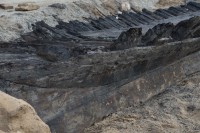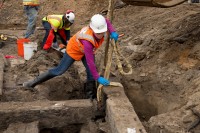 Archaeologists overseeing construction on the Potomac riverfront in Alexandria, Virginia, have found the well-preserved remains of a ship that was scuttled in the late 18th century. The 50-foot section of the port side of the hull, an estimated 1/3 of the original length of the ship, including some of the keel, frame, bow stem, stern and exterior boards and interior flooring, survived the centuries thanks to the waterlogged soil which kept oxygen and microbes from devouring the wood.
Archaeologists overseeing construction on the Potomac riverfront in Alexandria, Virginia, have found the well-preserved remains of a ship that was scuttled in the late 18th century. The 50-foot section of the port side of the hull, an estimated 1/3 of the original length of the ship, including some of the keel, frame, bow stem, stern and exterior boards and interior flooring, survived the centuries thanks to the waterlogged soil which kept oxygen and microbes from devouring the wood.
The ship is being thoroughly documented in situ via 3D laser scanning, high resolution photography and precise measurement. Each layer of the wood — archaeologists believe there are at least three — will be scanned and photographed before removal. An expert will examine the remains to identify the wood and date it precisely with dendrochronological analysis. The dismantled ship parts will be kept under water for preservation purposes — a lab has yet to be found that can accommodate it — while the city decides seeks funding for long-term conservation, study and possible display.
While we await an exact date based on when the trees were cut, historians have already pinpointed a tight date range by documentary study. The site was originally located on a bluff overlooking a Potomac cove. That cove was filled in to extend the property in the late 1700s. Historical maps showing how the shoreline changed in the second half of the 18th century provide a possible window for when the ship was buried of between 1775 and 1798.
The frame sections were placed very close together, an indication that the ship was built to carry heavy loads. It was likely a coast-hugging vessel rather than ocean-going, and while archaeologists tentatively believe it was a merchant ship, they cannot yet rule out that it had a military use. There is evidence of deliberate chopping of the hull, probably with a broad axe. This may have been done during the filling in the cove as the ship was chopped up to fit into the given space.
 The site of the future Indigo Hotel at 220 S. Union Street is part of a major redevelopment project of Alexandria’s historic waterfront. The ship is the second significant historical find in the one-block site. In September archaeologists unearthed the remains of a warehouse built in 1755 that is thought to be the first public building erected in Alexandria which was only six years old at the time. Historical records of a June 18th, 1755, meeting of the Trustees of Alexandria document their order that a warehouse “One hundred feet long twenty four feet wide thirteen feet Pitch’d To be three Divisions double strided” be constructed, and archaeologists found almost exactly that: the outline of a wooden building 90 feet long and 24 feet wide. The 10 missing feet were destroyed by later construction on the site.
The site of the future Indigo Hotel at 220 S. Union Street is part of a major redevelopment project of Alexandria’s historic waterfront. The ship is the second significant historical find in the one-block site. In September archaeologists unearthed the remains of a warehouse built in 1755 that is thought to be the first public building erected in Alexandria which was only six years old at the time. Historical records of a June 18th, 1755, meeting of the Trustees of Alexandria document their order that a warehouse “One hundred feet long twenty four feet wide thirteen feet Pitch’d To be three Divisions double strided” be constructed, and archaeologists found almost exactly that: the outline of a wooden building 90 feet long and 24 feet wide. The 10 missing feet were destroyed by later construction on the site.
With the stone foundations, large beam framing and even sections of the floor and interior walls surviving, the warehouse remains give historians the unique chance to explore mid-18th century construction elements like the extensive use of mortise and tenon joints even in the studs and beams, and to study the city’s very early commercial history. It was dismantled and sent to the Maryland Archaeological Conservation Lab in St. Leonard to be preserved in its tanks.
Unlike the warehouse whose location was recorded in the Trustees meeting, the discovery ship came as a complete surprise to excavators. There are no surviving records known that document its scuttling and installation, nor are any expected to be found.
“It’s very rare. This almost never happens,” said Dan Baicy, the hard-hatted field director for Thunderbird Archeology, the firm watching for historic evidence during construction. “In 15 years that I’ve done this work, I’ve never run into this kind of preservation in an urban environment where there’s so much disturbance.”